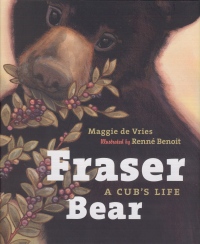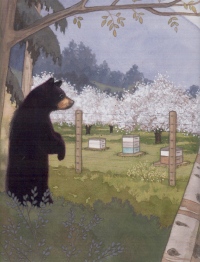| ________________
CM . . . . Volume XVIII Number 7 . . . . October 14, 2011

 |
Fraser Bear: A Cubís Life.
Maggie de Vries. Illustrated by Rennť Benoit.
Vancouver, BC: Greystone Books/D&M Publishers, 2010.
32 pp., hardcover, $19.95.
ISBN 978-1-55365-521-3.
Subject Headings:
Bear cubs-Juvenile literature.
Black bear-Juvenile literature.
Black bear-Food-British Columbia-Juvenile literature.
Pacific salmon-British Columbia-Fraser River-Juvenile literature.
Grades 3-6 / Ages 8-11.
Review by Vikki Houston.
*** /4
|
| |
|

excerpt:
May
The melt is on. Water rushes down the mountains.
The cubs are always hungry. Day after day, they follow their mother in search of new growth. They climb for it, up bare, slippery slopes. Many times a day, they stop to drink their motherís milk.
The mother bear is even hungrier than her cubs. She watches for food, and for danger.
Nearer now, the salmon that have survived the journey swim into the wide, muddy mouth of the Fraser River.
Fraser Bear: A Cubís Life follows the life of a black bear cub from birth to adulthood and the parallel life cycle of the salmon that the cub relies on for food. This book is more nonfiction than fiction even though it is written as a narrative. The book begins in January with two bear cubs cuddled in their den with their mother. The salmon have just begun their long trip back to their spawning grounds. The main character, Fraser, is given his name in February by a little girl helping her father, a biologist, to tag the mother bear. This is the only part of the story that is more fiction than nonfiction. The rest of the story describes the bears acting like bears in the wild as opposed to cartoon bears. The name Fraser is a reference to the setting of the story, in the Rocky Mountains of British Columbia by the Fraser River. The story is written in third person. The language in the book is easy to read and understand. Fraserís life is depicted accurately, and facts explaining the content are included in the back of the book. Perhaps because of this factual nature, I felt that this book would be a great teaching book, but not as good for recreational reading. As a teacher, I could see that this book would help students easily understand the intertwined lives of bears and salmon and give a glimpse into how a bear behaves in the wild. As far as picking this book up for a read aloud, I think that the book was too slow moving. The author used some descriptive words, but I never felt that I was transported into the setting. The main character, Fraser, is given his name in February by a little girl helping her father, a biologist, to tag the mother bear. This is the only part of the story that is more fiction than nonfiction. The rest of the story describes the bears acting like bears in the wild as opposed to cartoon bears. The name Fraser is a reference to the setting of the story, in the Rocky Mountains of British Columbia by the Fraser River. The story is written in third person. The language in the book is easy to read and understand. Fraserís life is depicted accurately, and facts explaining the content are included in the back of the book. Perhaps because of this factual nature, I felt that this book would be a great teaching book, but not as good for recreational reading. As a teacher, I could see that this book would help students easily understand the intertwined lives of bears and salmon and give a glimpse into how a bear behaves in the wild. As far as picking this book up for a read aloud, I think that the book was too slow moving. The author used some descriptive words, but I never felt that I was transported into the setting.
Renne Benoitís watercolour illustrations add to the nonfiction nature of this book. The illustrations enhance the text of the story by accurately portraying the bears and the natural setting. Benoit uses muted earth tones in her illustrations. Ironically, I thought that the front cover illustration of a bear catching salmon was more indicative of the content of the book than the illustration on the front of the dust jacket of a bear eating berries.
Fraser Bear: A Cubís Life is an excellent teacher resource but a limited read aloud.
Recommended with reservations.
Vikki Houston is a Lead Kindergarten teacher in Oshawa, ON.

To comment
on this title or this review, send mail to cm@umanitoba.ca.
Copyright © the Manitoba Library Association. Reproduction for personal
use is permitted only if this copyright notice is maintained. Any
other reproduction is prohibited without permission.
NEXT REVIEW |
TABLE OF CONTENTS FOR THIS ISSUE
- October 14, 2011.
AUTHORS |
TITLES |
MEDIA REVIEWS |
PROFILES |
BACK ISSUES |
SEARCH |
CMARCHIVE |
HOME |

 The main character, Fraser, is given his name in February by a little girl helping her father, a biologist, to tag the mother bear. This is the only part of the story that is more fiction than nonfiction. The rest of the story describes the bears acting like bears in the wild as opposed to cartoon bears. The name Fraser is a reference to the setting of the story, in the Rocky Mountains of British Columbia by the Fraser River. The story is written in third person. The language in the book is easy to read and understand. Fraserís life is depicted accurately, and facts explaining the content are included in the back of the book. Perhaps because of this factual nature, I felt that this book would be a great teaching book, but not as good for recreational reading. As a teacher, I could see that this book would help students easily understand the intertwined lives of bears and salmon and give a glimpse into how a bear behaves in the wild. As far as picking this book up for a read aloud, I think that the book was too slow moving. The author used some descriptive words, but I never felt that I was transported into the setting.
The main character, Fraser, is given his name in February by a little girl helping her father, a biologist, to tag the mother bear. This is the only part of the story that is more fiction than nonfiction. The rest of the story describes the bears acting like bears in the wild as opposed to cartoon bears. The name Fraser is a reference to the setting of the story, in the Rocky Mountains of British Columbia by the Fraser River. The story is written in third person. The language in the book is easy to read and understand. Fraserís life is depicted accurately, and facts explaining the content are included in the back of the book. Perhaps because of this factual nature, I felt that this book would be a great teaching book, but not as good for recreational reading. As a teacher, I could see that this book would help students easily understand the intertwined lives of bears and salmon and give a glimpse into how a bear behaves in the wild. As far as picking this book up for a read aloud, I think that the book was too slow moving. The author used some descriptive words, but I never felt that I was transported into the setting.